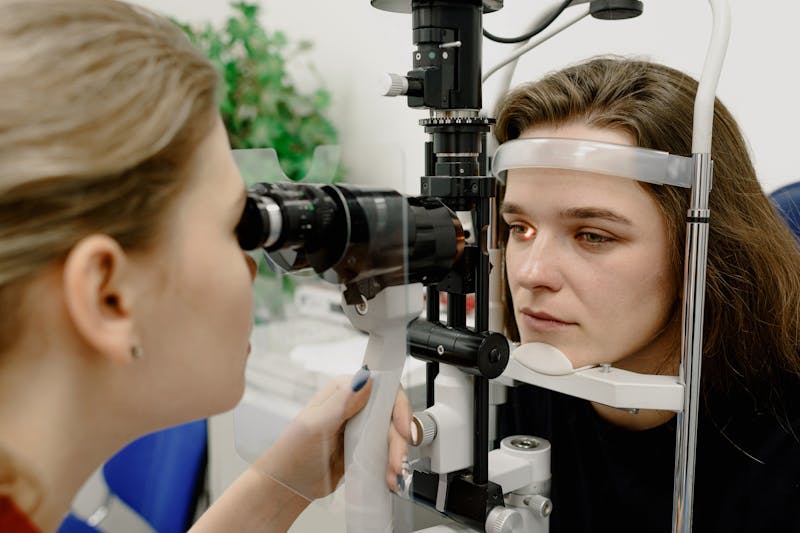Have you ever noticed eye strain after scrolling on your phone or felt dryness after a long day at work? Many assume clear vision means healthy eyes, but that misconception leaves you vulnerable to undetected issues. Through five practical tips—understanding your risks, daily eye protection, nutritional support, early warning sign recognition, and consistent follow-ups—regular eye tests on George St Sydney become your frontline defense. This proactive approach preserves vision, catches silent diseases early, and adapts to Australia’s unique environmental challenges, ensuring lifelong clarity and comfort.
Table of Contents
Why Eye Health Demands Attention in Australia
Australia’s vibrant lifestyle comes with hidden challenges for your eyes. Intense UV exposure, even on cloudy days, accelerates conditions like cataracts and macular degeneration. Simultaneously, our screen-dominated lives—averaging over 6 hours daily—contribute to digital eye strain, dryness, and blurred vision. These factors intersect uniquely in urban hubs like Sydney, where reflective surfaces from high-rises amplify glare and pollution can irritate sensitive eyes. Ignoring routine check-ups risks progressive damage, as many eye diseases advance silently. The good news? Australia boasts world-class optometry resources. Regular eye tests transform this access into actionable prevention, tailoring strategies to your age, genetics, and environment before minor issues escalate.
George St Sydney: Your Convenient Eye Care Hub
George St isn’t just Sydney’s bustling artery—it’s a strategic location for comprehensive eye care. Nestled among retail and business districts, clinics here cater to busy professionals, students, and families with extended hours and walk-in availability. Modern practices feature cutting-edge diagnostic tools: optical coherence tomography (OCT) scans retinal layers in microns, while visual field testers map peripheral vision loss linked to glaucoma. This precision matters because early detection of conditions like diabetic retinopathy can prevent irreversible vision loss. For city dwellers, the convenience of combining an eye test with daily errands removes barriers to care. Clinics near Town Hall or Wynyard stations simplify follow-ups, ensuring continuity in your eye health journey.
Debunking the “Perfect Vision” Myth
“Why schedule an eye test if I see fine?” This common oversight overlooks a critical fact: eye tests are health screenings, not just vision checks. Optometrists assess intraocular pressure (a glaucoma indicator), examine blood vessels for hypertension or diabetes signs, and evaluate retinal integrity. Conditions like macular degeneration can erode central vision for years before symptoms arise. A George St Sydney optometrist shared a case where a routine test revealed retinal thinning in a 40-year-old with “20/20” vision—early intervention halted progression. Your eyes also reflect systemic health; Australian clinics have detected brain tumors and autoimmune disorders through routine exams. Treating eye tests as preventative medicine, not reactive care, is the cornerstone of longevity in vision.
The Lifesaving Rhythm of Regular Eye Tests
Eye tests transcend prescription updates. They establish a personalized health timeline, comparing past and present data to spot subtle changes. This rhythm is vital: conditions like glaucoma cause permanent nerve damage before symptoms appear, while diabetic shifts can manifest in the retina within months. Australian guidelines recommend biennial tests for adults, but high-risk groups—over 65s, those with family history, or people with diabetes—need annual visits. For children, early testing corrects developmental issues like amblyopia (“lazy eye”), which becomes harder to treat after age seven.
Building Daily Protective Habits
Screen Smart Tactics: Beyond the 20-20-20 rule, calibrate device settings. Reduce blue light via night mode and position screens 50–70cm away, slightly below eye level. Anti-reflective coatings on lenses cut glare by 50%, while artificial tears combat screen-induced dryness. A 2023 University of Sydney study found workers using these strategies reported 70% less eye fatigue.
UV Defense Down Under: Not all sunglasses are equal. Choose Australian Standard AS/NZS 1067-compliant lenses blocking 100% UVA/UVB. Wrap-around styles prevent peripheral light entry, crucial for drivers or beachgoers. Polarized lenses are essential near water or roads, reducing glare-induced accidents. Pro tip: Cloudy days still deliver 80% UV radiation—wear sunglasses year-round.
Nutrition: The Overlooked Eye Shield
What you eat directly fuels retinal health. Key nutrients and Australian-sourced examples include:
- Vitamin A & Carotenoids: Beef liver (rich in retinol), sweet potatoes, and kale (beta-carotene sources) protect the cornea and sharpen night vision. Try roasted sweet potato with macadamia dukkah.
- Omega-3s: Sustain retinal cell structure. Source wild-caught Australian salmon (1,500mg per 150g serve) or flaxseeds in morning smoothies.
- Zinc & Antioxidants: Oysters (highest zinc concentration) and Kakadu plums (world’s richest vitamin C source) shield against UV oxidative damage.
Australian researchers found diets high in leafy greens and fish slowed age-related macular degeneration (AMD) progression by 25%. For office workers, snack on almonds (vitamin E) and blueberries (anthocyanins) to combat screen strain.
Recognizing Silent Alarms: From Blur to Blindness
Early symptom detection saves sight. Warning signs include:
|
Condition |
Early Symptoms |
Critical Window for Action |
|
Glaucoma |
Tunnel vision, haloed lights |
6–12 months before nerve damage |
|
Cataracts |
Faded colors, night driving difficulty |
1–2 years before surgery needed |
|
Macular Degeneration |
Distorted lines (e.g., wavy door frames) |
3–6 months to preserve central vision |
George St Sydney clinics use advanced screenings like OCT angiography, visualizing blood flow without dyes. One patient avoided vision loss when this test revealed abnormal vessels—an early diabetic retinopathy sign—despite perfect blood sugar readings.
Navigating Medicare & Choosing Your Optometrist
Medicare covers eye tests every 3 years for under-65s and annually for over-65s or those with conditions like diabetes. Bulk-billed clinics on George St Sydney include those affiliated with OPSM or independent practices like George Street Eyecare. When selecting a provider:
- Verify Australian Health Practitioner Regulation Agency (AHPRA) registration.
- Prioritize clinics offering dilated exams, essential for retinal assessment.
- Ask about telehealth follow-ups for prescription reviews.
Conclusion: Your Vision, Your Future
Your eyes are irreplaceable sensors navigating the world. In Australia’s harsh climate and digital age, passive care risks gradual decline. The five pillars outlined—risk awareness, daily protection, targeted nutrition, symptom vigilance, and consistent testing—form an integrated shield. George St Sydney’s clinics offer the technology and expertise to personalize this approach, turning urban convenience into lifelong visual freedom. Whether you’ve delayed tests due to time or perceived wellness, remember: the most treatable eye conditions are those caught before symptoms arise. Book your comprehensive eye test today—not because you see poorly, but because you deserve to see everything brilliantly tomorrow.

